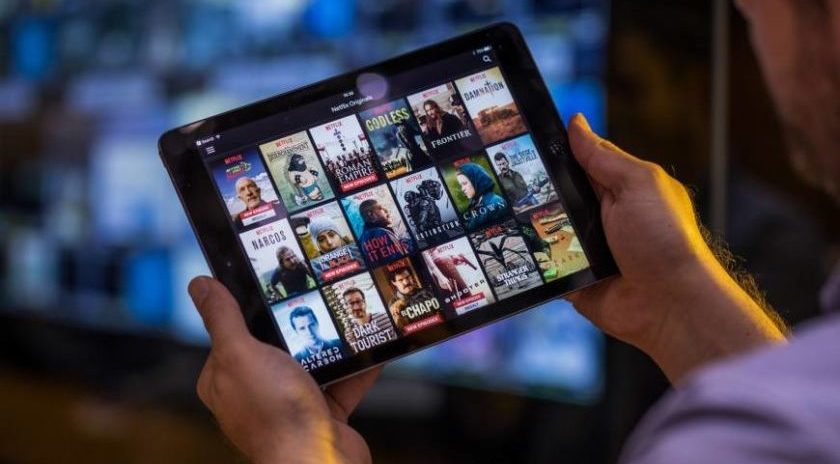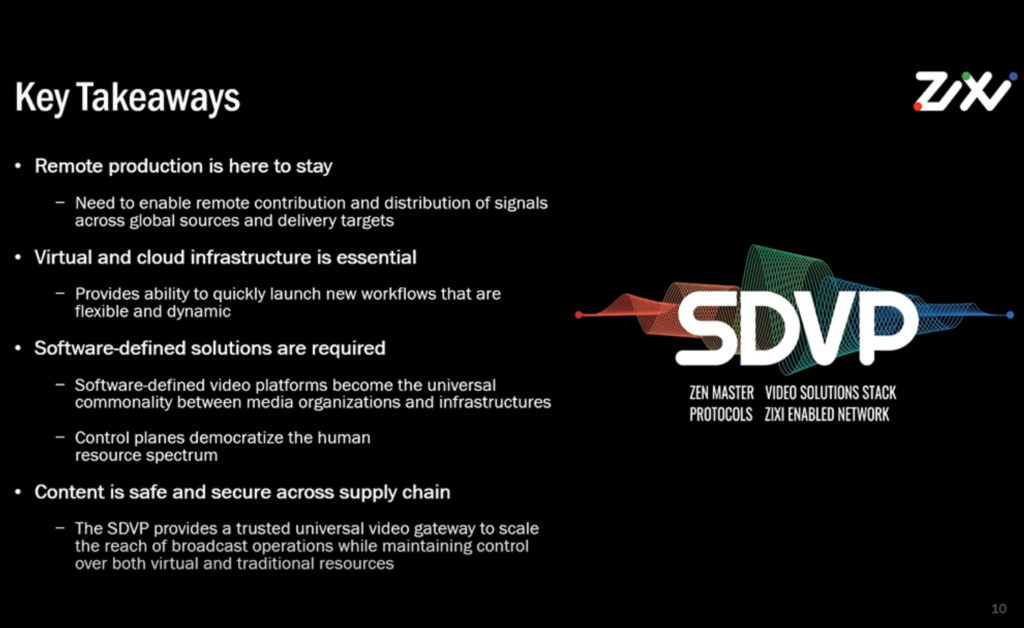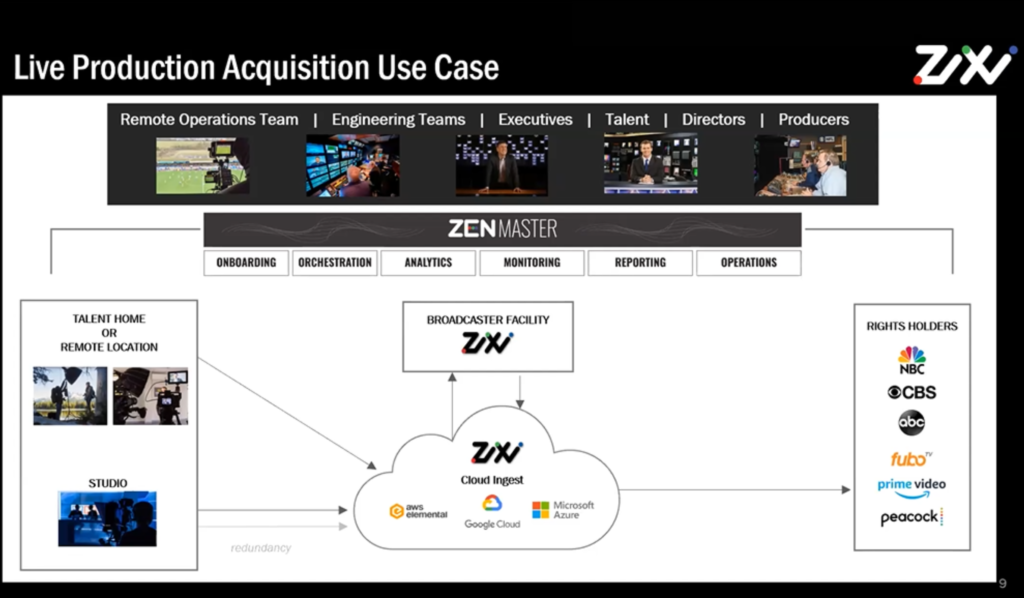
Zixi: Broadcast-Quality Video Can Be Delivered Remotely With its SDVP
A growing number of media and entertainment companies are looking for a solution to distribute broadcast-quality video from remote locations, and Zixi’s Software-Defined Video Platform (SDVP) can deliver that with scale, according to Eric Bolten, VP of business development at Zixi.
The SDVP enables broadcast-quality delivery across any IP network, any protocol, any cloud provider and any edge device, allowing companies to seamlessly and securely pivot from on-premise production and control rooms to remote virtualized broadcast operations securely and at scale, he explained during the Dec. 8 virtual Content Protection Summit.
Combining Zixi’s SDVP with ZEN Master, its virtual control plane, remote users can maintain business continuity and securely orchestrate, manage and monitor broadcast quality, low latency live video workflows from anywhere in the world, he pointed out during the Scale & Remote Access breakout session “Securely Scaling Remote Broadcast-Quality Video Production.”
 As a result of the “black swan” COVID-19 pandemic, “the commitment to the cloud has been moved forward,” he noted, adding: “For things that would have occurred in the next two years, we believe that that has been brought forward to a sort of overnight necessity.”
As a result of the “black swan” COVID-19 pandemic, “the commitment to the cloud has been moved forward,” he noted, adding: “For things that would have occurred in the next two years, we believe that that has been brought forward to a sort of overnight necessity.”
The media industry is currently undergoing a rapid move to cloud virtualization, he said. Pointing to the findings of a recent poll of about 200 executives in the industry, he noted: 97% of the media executives said they believe that shift to the cloud will provide new revenue opportunities; 93% said they believe it will provide cost saving opportunities; 95% said they believe it will drive faster cloud adoption; and 93% said they believe it requires more telemetry data and orchestration.
Pointing to the benefits of a cloud-based broadcast infrastructure, he said, it provides:
- More efficiency: Cloud virtualization allows for a more cost-effective, sustainable broadcast infrastructure.
- More flexibility: The flexibility and iterative nature of software-defined live streaming solutions have become “mission critical.”
- More interoperability: The need for interoperability between different levels of protocols, platforms, edge devices, media processing and encoders/decoders.
With the solution, you can quickly have a “new set of infrastructures” and go from “multiple public clouds, multiple providers – public and private,” Bolten said, adding: “There’s a lot of flexibility that allows you to be iterative, do pop-up channels, do backups, have different signal paths. Of course this will open to the door for cloud playout, which can lead you to delivery to standard MSOs as well as OTT pieces and then there’ll be 5G. And within all of this virtual infrastructure, interoperability becomes critical.”
When it comes to cloud-based live television workflow, “one of the things that’s happened over 2020 is the advent of the virtual control room and virtual master control room,” he went on to say.
“Live production had to go overnight” from being an “on-premise-type set of infrastructures to a virtualized one,” he said. Since the early days of the pandemic, sports events have “made a comeback” and entertainment and news continue to be in heavy demand, he noted.
 “Cloud-originated” content is “working towards all kinds of new delivery models that are going forward across the traditional to the digital spectrum,” he also said. As a result, he explained: “You need to have security and you’re going to need to have and be able to operate this at scale. You’re going to need to connect to your standard operators – whether it’s control room or master control. And you’re going to need to be able to have coordination between your engineering teams – whether they’re broadcast engineers, IT engineers, network engineers – the whole group. And knowing that all of these resources are relatively scarce, being able to connect, leverage and orchestrate them becomes critical.”
“Cloud-originated” content is “working towards all kinds of new delivery models that are going forward across the traditional to the digital spectrum,” he also said. As a result, he explained: “You need to have security and you’re going to need to have and be able to operate this at scale. You’re going to need to connect to your standard operators – whether it’s control room or master control. And you’re going to need to be able to have coordination between your engineering teams – whether they’re broadcast engineers, IT engineers, network engineers – the whole group. And knowing that all of these resources are relatively scarce, being able to connect, leverage and orchestrate them becomes critical.”
The Zixi SDVP software layer serves as a universal video gateway enabling traditional and digital workflows across internal and external media supply chains through one secure platform, he said. With it, he explained: “You can contribute once and then deliver to any” distribution method because “SDVP delivers live video across any protocol, any IP network, any cloud, all service providers, with any edge device.”
In addition to Zixi’s own protocol, it supports 17 protocols in all, he also told viewers, adding: “If you’re going to be deploying live video workflow, while it does start out as project by project, these projects quickly begin to interlace and come together, and having a common platform that is comprehensive and software-based means” you have a lot of flexibility and can, for example, “manage things from a local to a regional, national and international level.”
Zixi’s ZEN Master control plane enables secure remote workflow management with visual tools to configure, orchestrate, manage and monitor live broadcast channels at scale across industry protocols and an entire supply chain of integrated services and devices, according to the company.
 Key ZEN Master features include: Its ability to provide visibility across any protocols, IP network, cloud, service provider and edge device; it providees remote workflow management with “telemetry across metrics at an atomic level”; it can perform Root Cause Analysis across the media supply chain; it offers abstract complexity to reduce engineering requirements and leverage operational resources; and it offers democratized access with geographic agility, according to Zixi.
Key ZEN Master features include: Its ability to provide visibility across any protocols, IP network, cloud, service provider and edge device; it providees remote workflow management with “telemetry across metrics at an atomic level”; it can perform Root Cause Analysis across the media supply chain; it offers abstract complexity to reduce engineering requirements and leverage operational resources; and it offers democratized access with geographic agility, according to Zixi.
Zixi’s solution is also “highly secure,” Bolten said. Its “best-in-class” security protocols and the “most sophisticated protection are among the biggest reasons why customers and partners choose to send their content using the SDVP,” according to Zixi. In addition, it says: “All streaming data that moves through the Zixi Enabled Network of integrated software and devices is protected using a multi-layered security approach.”
Moving on the “key takeaways” of the presentation, Bolten said:
- “Remote production is here to stay.” As a result, there is a need to enable remote contribution and distribution of signals across global sources and delivery targets.
- “Virtual and cloud infrastructure is essential.” It provides the ability to quickly launch new workflows that are flexible and dynamic.
- “Software-defined solutions are required.” SDVPs become the universal commonality between media organizations and infrastructures, while control planes democratize the human resources spectrum.
- “Content is safe and secure across [the] supply chain”: The SDVP offers a trusted universal video gateway to scale the reach of broadcast operations while maintaining control over both virtual and traditional resources.
To view the full presentation, click here. To view the presentation slide deck, click here.
Presented by Microsoft Azure, the Content Protection Summit was sponsored by SHIFT, Genpact, Akamai, Convergent Risks, Friend MTS, GeoGuard, PacketFabric, Palo Alto Networks, Richey May Technology Solutions, Splunk, Zixi, EIDR, Cyberhaven and Xcapism Learning.
The event was produced by MESA, CDSA, the Hollywood IT Society (HITS) and Women in Technology Hollywood (WiTH), under the direction of the CDSA Board of Directors and content advisors representing Amazon Studios, Adobe, Paramount, BBC Studios, NBCUniversal, Lionsgate, WarnerMedia, Amblin Entertainment, Legendary Pictures, and Lego Group.
